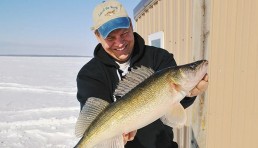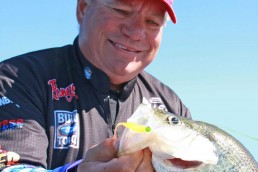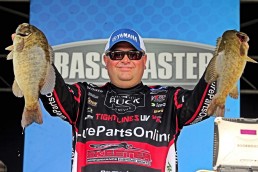Ten Tips for Icing More Walleyes This Winter
SHARE THIS POST
“Man, we are seeing a lot of fish coming through on the electronics, but they are just not eating…”
Ok, let’s take another perspective on this. First off, they may or may not be eating, but the question is, can we get them to bite.
Are you enjoying this post?
You can be among the first to get the latest info on where to go, what to use and how to use it!
There are definitely ways to increase your catch:
- The norm. Jig, jig and let it sit in the strike zone. Jig, jig, jig and let it sit in the strike zone. This technique catches thousands of walleyes. Yet, there are times when the walleyes and saugers seem a bit unresponsive. What then? That’s when it is time to mix it up.
- Ratta-tap-tap. When you see that fish come in and it isn’t whacking, try shaking your rod tip as fast as you can. I also take and tap my fingers on the butt of my rod as fast as I can, sending vibrations down to the lure. This often induces a solid “tap” or that extra weight of an ‘eye or sauger.
- Thrill of the chase. When a walleye is watching your lure, but not hitting it, try jigging the lure while raising your lure higher and higher in the water column. This emulates the prey trying to get away. When that fish is following up, don’t slow down. Keep the lure rising just ahead of the chasing fish. Either that fish will fly up, close the gap and hit your lure, or that fish will come off the bottom a bit and go back down. When it goes back down, try teasing them up again or try another strike-inducing technique. A tip: Use your reel to raise your lure in the water column vs. using your arms. If you use your arms to raise the bait, there is nothing left to set the hook when the walleye hits and pushes your lure up.
- Pound the bottom. Another successful technique to not only get the fish to bite, but to also attract them, is to pound the bottom with your lure and lift off slowly. This will not only give off vibrations in the water, but it also stirs up the mud or sand representing some living creature the walleyes are used to eating. Be ready when you lift off the bottom, as if there is extra weight, you’ll have to set the hook. Sometimes walleyes will grab on subtly and it takes a good stick to detect.
- Rip ‘em. When fish seem sluggish, I often go against the grain and rip a Cicada or other type of vibrating blade lure. This aggressive 3-foot jigging motion gets that blade bait vibrating. And even when things are slow, one of two things will happen: Either out of nowhere, a bright red line (a fish) will appear on the electronics. This fish is hot and all I need to do is put my lure in front of it, jiggle it and most of the time that fish nails it. The other scenario is the erratic vibration will pull the fish in and they will end up swimming over to my dead stick—and the bobber goes down. Either way, I win. My favorite color on Lake of the Woods is gold with dark green tape. I also like the smaller sizes.
- Go micro. When fishing gets tough and I cannot figure the fish out, one technique that has helped me fill the bucket is going small. Often, I will take a very small panfish-sized Swedish Pimple-type lure and add a waxworm to it. I will work this close to the bottom and I have actually done very well when others can’t touch them. I know one friend who actually keeps some freeze-dried waxies in his arsenal in the event he has to turn to this unexpectedly. On many occasions, this turned out to be the ticket.
- Work the combo. Jigging a lure with live bait has typically produced the majority of walleyes for me. I will say that some days the dead sticks or bobber lines will outproduce. Under a dead stick, I either like a gold or glow jig-type lure with a live minnow, or a plain hook with split shot set above it with a live minnow.
- Simple jigging. I know some great ice anglers on Lake of the Woods who will always have one line rigged with a jig. They either hook the minnow through the head or thread the hook through the mouth, out the gill and through the mid section of the body (for a better percentage of hook sets). No bobber is used. Often, after jigging, the rod is set on the top of a 5-gallon pail, so the rod tip is in good view. Often, the tip of the rod will go down just a bit. Set the hook. It took me a few trips of watching this technique outproduce a jigging spoon that got my attention.
- Tipping lures with bait. I normally tip my jigging lures with a minnow head or the tail section of a minnow. Frozen shiners, fatheads and crappie minnows are staples for me. I like the way the fatheads and crappie minnows stay on the hooks when I am jigging. I like the scales and smell of the frozen shiners, but am careful to hook the piece of minnow in a spot that will hold as they are more fragile and will come off easier. With the frozen shiners, pinching them off behind the gills and carefully hooking the shiner head without creating too big a hole that the bait falls off, is the key. I also use the tail section, as hooking through the backbone of the minnow is very secure and has good flash.
- Change it up. The bottom line: When you know there are fish below you and they are not going, do something different. First, try different presentation methods with the same lure. Next, switch colors. Finally, change the lure.
Add these tools to your tool belt this year and notice what happens to the day’s catch.
MWO
SHARE THIS POST
Did you enjoy this post?
You can be among the first to get the latest info on where to go, what to use and how to use it!
Joe Henry
Tournament angler and licensed charter captain Joe Henry fishes and hunts the Midwest. Henry is a media member of AGLOW and writes for numerous publications, creates videos, appears on a variety of outdoor TV and radio shows and is a frequent seminar speaker. Henry is the Executive Director of Lake of the Woods Tourism.



